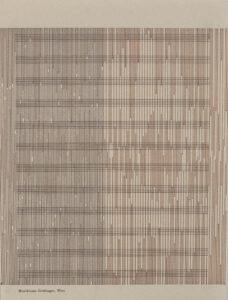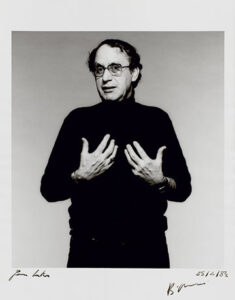
Kammerer-Luka (1929-2023)
______________________________________________________________________________________________________________
In 1971, the artist Gerhard F Kammerer, who works under the name Kammerer-Luka, met the computer scientist Jean-Baptiste Kempf. The former, born in Germany but living in Belfort, France, had been pushing the limits of his programmatic art, born from the principles of the Bauhaus, but felt that he could explore new territory if given the chance.
He knew the machine could afford him new artistic vistas. The two men felt an instant affinity and founded the Groupe Art & Ordinateur de Belfort, with the intent of using their calculations not only to explore artistic territory but to implement the tools that touched on social involvement and architecture.
Kempf, born in January 1941 in Belfort, was teaching the FORTRAN programming language at the university and Kammerer was a linguistics specialist. Language was the bedrock of their work. In 1973, they applied their principles to the underground pedestrian passage at the Belfort train station, using colored tiles in a double Fibonacci sequence. Other architectural projects followed, as well as a multitude of studio artistic creations.
They two were soon exhibiting among the small group of pioneers in digital/ computer art in France and abroad. They even participated in the first exhibition of digital art at the Centre Pompidou in 1978.
By the mid 1970s, Kempf was hired to head the computer research department at a electric company in Clamart and then to head the computer department of the electricity company in Lyon, France. Kammerer always had provided the artistic impetus and direction for the duo, with Kempf doing the programming.
Between 1977 and 1979, Kammerer came to Paris where he worked in the ARTA workshop at the Centre Pompidou, created by Christian Cavadia in 1975 to give artists (and members of the broader public) the opportunity to use computers for creative work.
One of the main draws was ARTA’s sophisticated plotter drawing table.
Besides himself, many artists, such as Vera Molnar, availed themselves the opportunity to work in Cavadia’s studio at the museum.
ARTA’s impact on the creative digital community remains to be researched with any serious scholarship. ARTA closed in 1983 due to political bickering at the Centre Pompidou.
Many of the drawings Kammerer made during this period show musical motifs in the form of lines almost traced like staves on the paper in varying sequences. Other motifs resemble alphabets and ancient hieroglyphs. Kammerer had long been interested in the ancient-contemporary crossover. His Daedalus, Orpheus and Ikarus works made references to mythology. Daedalus and Ikarus, for instance, embraced a programming error with a pyramid labyrinth. On one side is light shape and on the other a heavy one.
“The Daedalus and Ikarus theme represents the two-fold sense of computer-generated art: the most complex technology in the service of spiritual flight” said Kammerer-Luka. The random distribution of
basic elements was essential to Kammerer-Luka. The programs used specified a reduced repertoire
of shapes and a pattern composition from which a large number of possibilities may be born. This dialectic between systems and chance were expressed in many forms. For example, in the random
disorganization of Lissajous figure with the dot as a primal element.
“Working with the computer means that I am primarily interested in the quantitative and qualitative potentiality of creative possibilities through the systematic evaluation of artistic ideas,” said the artist
